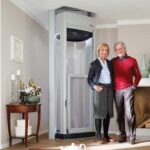Home elevators bring accessibility, safety, and luxury into multi-level Dubai residences. This guide helps homeowners and developers choose the right lift type, estimate costs for 2025, and understand installation and certification requirements.
TL;DR
- The home elevators improve accessibility and property value. Prices in Dubai (2025) typically range from AED 94,505 to AED 148,200. Pneumatic (vacuum) lifts install fast with minimal structure changes. Choose certified models (EN 81-41, TÜV) and plan yearly maintenance.
Technology & Features
Different technologies suit different homes and needs.
Definition: A home elevator is a compact residential vertical transport system for 1–3 passengers.
Common types include MRL (machine room-less), hydraulic, and vacuum/pneumatic lifts. *Vacuum lifts* use air pressure to move a capsule and often require no pit or machine room. Capsule and glass lifts give a modern look and panoramic views. MRL units save space and energy and fit modern villas well.
Smart features: touch panels, smartphone controls, and integration with home automation platforms. Many models offer wheelchair-accessible cabins and low thresholds for easier entry.
Cost & ROI
Costs depend on type, finish, and installation complexity.
Typical 2025 price ranges in the UAE run from AED 94,505 to AED 148,200. Factors that raise cost include custom finishes, glass enclosures, and longer travel heights. Maintenance and electricity add to total ownership costs.
ROI: Elevators increase usability for aging occupants and can boost resale appeal in Dubai’s market. Expect improved marketability in luxury and accessible housing segments.
Installation & Logistics
Installation time varies by elevator technology and existing structure.
Pneumatic lifts can be fitted in 2–3 days with minimal structural work and no pit. MRL and hydraulic installations take longer and may require a small pit or shaft. Retrofitting into an existing villa often needs structural assessment and possibly minor wallwork.
Space needs: Dumbwaiters require very little space, while full passenger lifts need a shaft roughly the size of a small room. Contractors usually provide a site survey and 3D drawings prior to work.
Safety & Certification
Safety standards protect residents and reduce liability.
Look for compliance with EN 81-41 and third-party certification such as TÜV SÜD. These standards cover emergency braking, door interlocks, and safe evacuation procedures. Dubai authorities accept many international certifications, but local approval may still be required.
Maintenance schedule: Annual inspections and occasional component servicing keep lifts safe. Many suppliers offer service contracts and 24/7 emergency support.
Choosing a Supplier
Pick suppliers who combine local experience with recognized certifications.
Royal Fuji Star provides a wide range of residential models and in-UAE service coverage. You can review their offerings on the Royal Fuji Star home elevators page.. Choose vendors who provide site surveys, warranty, and aftercare.
Check credentials and request references. Confirm that the supplier handles permits and coordinates with local authorities like the Dubai Municipality. For safety certification details consult a testing body such as TÜV SÜD.
Maintenance & Running Costs
Regular maintenance keeps performance consistent and safe.
Budget for annual inspections, occasional part replacements, and electricity. Typical service contracts cover preventive maintenance and emergency call-outs. Energy-efficient drives and LED cabin lighting reduce running costs.
Tip: Keep a maintenance log and schedule manufacturer-recommended checks.
Real-World Examples
Short installation and retrofits showcase quick wins for Dubai homes.
A villa retrofit used a panoramic pneumatic lift to add accessibility without major structural changes. Another project integrated a smart elevator with the home automation system for voice control and scheduled diagnostics.
Summary
Home elevators deliver accessibility, style, and long-term value for Dubai residences. Choose the right technology for your space, verify certifications, and plan for ongoing maintenance. Contact an experienced supplier like Royal Fuji Star for a site survey, quote, and local support via their home elevators page.
FAQs
How do vacuum/pneumatic home elevators work in Dubai?
They use air pressure differences to lift a sealed cabin inside a vertical tube, often without a pit or machine room.
What smart home integration options exist?
Most modern lifts support touch panels, remote call via apps, and integration with platforms like Home Assistant or commercial automation hubs.
Are there wheelchair-accessible models available?
Yes. Many passenger lifts offer wheelchair-accessible cabins and low-threshold doors for compliance and comfort.
How much does a home elevator cost in Dubai in 2025?
Typical prices range from AED 94,505 to AED 148,200 depending on model, travel height, and finishes.
Can a home elevator be installed without major renovation?
Certain vacuum and MRL systems can be installed with minimal renovation, sometimes in a few days.
Which certifications apply to home elevators in Dubai?
Look for EN 81-41 compliance and TÜV or ISO certifications; local approvals may still be required.

